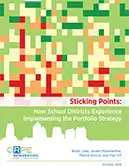Since 2013, CRPE has published annual “dashboards” of districts’ progress on portfolio strategy implementation. We recently analyzed the data on trends across all portfolio districts, breaking it down by the strategy’s seven key components. This report shows quite starkly where cities are moving ahead rapidly and where they are getting bogged down for technical or political reasons.
Key findings:
- While a handful of districts are at an “advanced” level of portfolio strategy implementation, too many are moving very slowly or are stalled.
- Some districts are implementing portfolio strategy in a piecemeal fashion that is unlikely to produce significant results for students.
- A group of districts not well known for portfolio implementation has been making a lot of progress lately.
- Districts tend to get “stuck” on or avoid the parts of portfolio systems that require a fundamental restructuring of the central office or changes to the union contract.
- It will take leadership at the state and local level to overcome barriers, and sustained progress is likely to require state action.
Portfolio is a local phenomenon, but it is inevitably linked to the state. At a minimum, portfolio needs some permissive state laws and regulations that localities can use to give schools more control over staffing, budgets, and purchasing. An even better scenario is to have state officials help clear out laws and regulations that get in the way of portfolio strategies and provide political support for forward-thinking local leaders.







